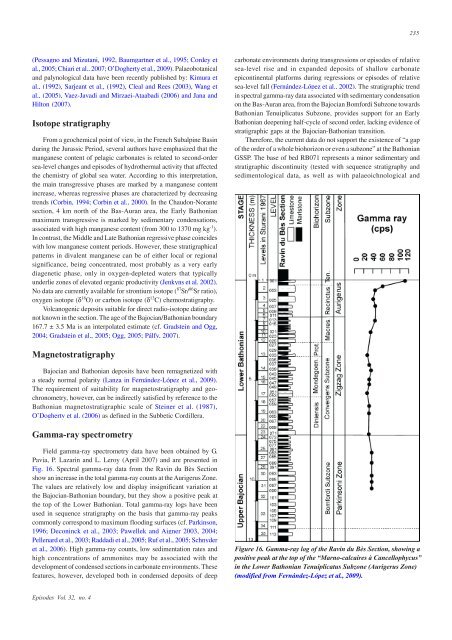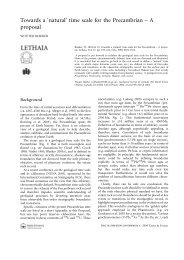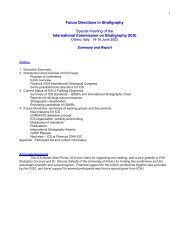The Global Boundary Stratotype Section and Point (GSSP) for base ...
The Global Boundary Stratotype Section and Point (GSSP) for base ...
The Global Boundary Stratotype Section and Point (GSSP) for base ...
You also want an ePaper? Increase the reach of your titles
YUMPU automatically turns print PDFs into web optimized ePapers that Google loves.
(Pessagno <strong>and</strong> Mizutani, 1992, Baumgartner et al., 1995; Cordey et<br />
al., 2005; Chiari et al., 2007; O’Dogherty et al., 2009). Palaeobotanical<br />
<strong>and</strong> palynological data have been recently published by: Kimura et<br />
al., (1992), Sarjeant et al., (1992), Cleal <strong>and</strong> Rees (2003), Wang et<br />
al., (2005), Vaez-Javadi <strong>and</strong> Mirzaei-Ataabadi (2006) <strong>and</strong> Jana <strong>and</strong><br />
Hilton (2007).<br />
Isotope stratigraphy<br />
From a geochemical point of view, in the French Subalpine Basin<br />
during the Jurassic Period, several authors have emphasized that the<br />
manganese content of pelagic carbonates is related to second-order<br />
sea-level changes <strong>and</strong> episodes of hydrothermal activity that affected<br />
the chemistry of global sea water. According to this interpretation,<br />
the main transgressive phases are marked by a manganese content<br />
increase, whereas regressive phases are characterized by decreasing<br />
trends (Corbin, 1994; Corbin et al., 2000). In the Chaudon-Norante<br />
section, 4 km north of the Bas-Auran area, the Early Bathonian<br />
maximum transgressive is marked by sedimentary condensations,<br />
associated with high manganese content (from 300 to 1370 mg kg -1 ).<br />
In contrast, the Middle <strong>and</strong> Late Bathonian regressive phase coincides<br />
with low manganese content periods. However, these stratigraphical<br />
patterns in divalent manganese can be of either local or regional<br />
significance, being concentrated, most probably as a very early<br />
diagenetic phase, only in oxygen-depleted waters that typically<br />
underlie zones of elevated organic productivity (Jenkyns et al. 2002).<br />
No data are currently available <strong>for</strong> strontium isotope ( 87 Sr/ 86 Sr ratio),<br />
oxygen isotope (δ 18 O) or carbon isotope (δ 13 C) chemostratigraphy.<br />
Volcanogenic deposits suitable <strong>for</strong> direct radio-isotope dating are<br />
not known in the section. <strong>The</strong> age of the Bajocian/Bathonian boundary<br />
167.7 ± 3.5 Ma is an interpolated estimate (cf. Gradstein <strong>and</strong> Ogg,<br />
2004; Gradstein et al., 2005; Ogg, 2005; Pálfy, 2007).<br />
Magnetostratigraphy<br />
Bajocian <strong>and</strong> Bathonian deposits have been remagnetized with<br />
a steady normal polarity (Lanza in Fernández-López et al., 2009).<br />
<strong>The</strong> requirement of suitability <strong>for</strong> magnetostratigraphy <strong>and</strong> geochronometry,<br />
however, can be indirectly satisfied by reference to the<br />
Bathonian magnetostratigraphic scale of Steiner et al. (1987),<br />
O’Dogherty et al. (2006) as defined in the Subbetic Cordillera.<br />
Gamma-ray spectrometry<br />
Field gamma-ray spectrometry data have been obtained by G.<br />
Pavia, P. Lazarin <strong>and</strong> L. Leroy (April 2007) <strong>and</strong> are presented in<br />
Fig. 16. Spectral gamma-ray data from the Ravin du Bès <strong>Section</strong><br />
show an increase in the total gamma-ray counts at the Aurigerus Zone.<br />
<strong>The</strong> values are relatively low <strong>and</strong> display insignificant variation at<br />
the Bajocian-Bathonian boundary, but they show a positive peak at<br />
the top of the Lower Bathonian. Total gamma-ray logs have been<br />
used in sequence stratigraphy on the basis that gamma-ray peaks<br />
commonly correspond to maximum flooding surfaces (cf. Parkinson,<br />
1996; Deconinck et al., 2003; Pawellek <strong>and</strong> Aigner 2003, 2004;<br />
Pellenard et al., 2003; Raddadi et al., 2005; Ruf et al., 2005; Schnyder<br />
et al., 2006). High gamma-ray counts, low sedimentation rates <strong>and</strong><br />
high concentrations of ammonites may be associated with the<br />
development of condensed sections in carbonate environments. <strong>The</strong>se<br />
features, however, developed both in condensed deposits of deep<br />
Episodes Vol. 32, no. 4<br />
235<br />
carbonate environments during transgressions or episodes of relative<br />
sea-level rise <strong>and</strong> in exp<strong>and</strong>ed deposits of shallow carbonate<br />
epicontinental plat<strong>for</strong>ms during regressions or episodes of relative<br />
sea-level fall (Fernández-López et al., 2002). <strong>The</strong> stratigraphic trend<br />
in spectral gamma-ray data associated with sedimentary condensation<br />
on the Bas-Auran area, from the Bajocian Bom<strong>for</strong>di Subzone towards<br />
Bathonian Tenuiplicatus Subzone, provides support <strong>for</strong> an Early<br />
Bathonian deepening half-cycle of second order, lacking evidence of<br />
stratigraphic gaps at the Bajocian-Bathonian transition.<br />
<strong>The</strong>re<strong>for</strong>e, the current data do not support the existence of “a gap<br />
of the order of a whole biohorizon or even a subzone” at the Bathonian<br />
<strong>GSSP</strong>. <strong>The</strong> <strong>base</strong> of bed RB071 represents a minor sedimentary <strong>and</strong><br />
stratigraphic discontinuity (tested with sequence stratigraphy <strong>and</strong><br />
sedimentological data, as well as with palaeoichnological <strong>and</strong><br />
Figure 16. Gamma-ray log of the Ravin du Bès <strong>Section</strong>, showing a<br />
positive peak at the top of the “Marno-calcaires à Cancellophycus”<br />
in the Lower Bathonian Tenuiplicatus Subzone (Aurigerus Zone)<br />
(modified from Fernández-López et al., 2009).




